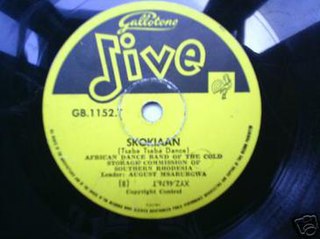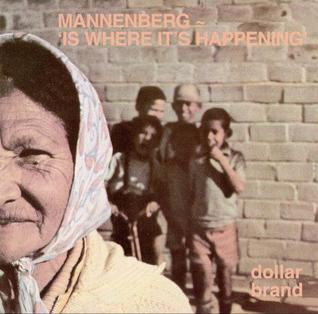Related Research Articles
Jazz is a music genre that originated in the African-American communities of New Orleans, Louisiana, in the late 19th and early 20th centuries, with its roots in blues and ragtime. Since the 1920s Jazz Age, it has been recognized as a major form of musical expression in traditional and popular music. Jazz is characterized by swing and blue notes, complex chords, call and response vocals, polyrhythms and improvisation. Jazz has roots in European harmony and African rhythmic rituals.
Given the vastness of the African continent, its music is diverse, with regions and nations having many distinct musical traditions. African music includes the genres amapiano, jùjú, fuji, afrobeat, highlife, Congolese rumba, soukous, ndombolo, makossa, kizomba,Taarab and others. African music also uses a large variety of instruments from all across the continent. The music and dance of the African diaspora, formed to varying degrees on African musical traditions, include American music like Dixieland jazz, blues, jazz, and many Caribbean genres, such as calypso and soca. Latin American music genres such as cumbia, salsa music, son cubano, rumba, conga, bomba, samba and zouk were founded on the music of enslaved Africans, and have in turn influenced African popular music.

The United States' multi-ethnic population is reflected through a diverse array of styles of music. It is a mixture of music influenced by the music of Europe, Indigenous peoples, West Africa, Latin America, Middle East, North Africa, amongst many other places. The country's most internationally renowned genres are traditional pop, jazz, blues, country, bluegrass, rock, rock and roll, R&B, pop, hip-hop/rap, soul, funk, religious, disco, house, techno, ragtime, doo-wop, folk, americana, boogaloo, tejano, reggaeton, surf, and salsa, amongst many others. American music is heard around the world. Since the beginning of the 20th century, some forms of American popular music have gained a near global audience.

Zimbabwean music is heavily reliant on the use of instruments such as the mbira, Ngoma drums and hosho. Their music symbolizes much more than a simple rhythm, as the folk and pop style styled music was used as a symbol of hope for Zimbabweans looking to gain independence from Rhodesia. Music has played a significant role in the history of Zimbabwe, from a vital role in the traditional Bira ceremony used to call on ancestral spirits, to protest songs during the struggle for independence. The community in Zimbabwe used music to voice their resistance to their oppression, as one of the only weapons they had available to fight back with. In the eighties, the Music of Zimbabwe was at the center of the African Music scene thanks to genres such as Sungura and Jit. However, several performers were banned by state TV and radio leading to the closing of several music venues.

The South African music scene includes both popular (jive) and folk forms like Zulu isicathamiya singing and harmonic mbaqanga. Other popular genres are marabi, kwaito,house music, pop music, isicathamiya, gqom, rock music, hip hop and amapiano.
Kwaito is a music genre that emerged in Soweto, Johannesburg, South Africa, during the 1980s. It is a variant of house music that features the use of African sounds and samples. Kwaito songs occur at a slower tempo range than other styles of house music and often contains catchy melodic and percussive loop samples, deep bass lines, and vocals. Despite its similarities to hip hop music, kwaito has a distinctive manner in which the lyrics are sung, rapped and shouted.
Mbaqanga is a style of South African music with rural Zulu roots that continues to influence musicians worldwide today. The style originated in the early 1960s, and blends traditional African vocal styles and melodies with European and American popular music.
Kwela is a pennywhistle-based street music from southern Africa with jazzy underpinnings and a distinctive, skiffle-like beat. It evolved from the marabi sound and brought South African music to international prominence in the 1950s.
The folkloric traditional music of Paraguay is the Paraguayan polka and the Guarania. The Paraguayan polka comes from polka of Czech origin; that was danced for the first time in Asunción, on November 27, 1858. The guarania was created by the Paraguayan musician José Asunción Flores, in January 1925, after experiencing different arrangements with the old Paraguayan musical theme "Ma'erãpa reikuaase". Paraguay also has classical music and popular music consisting of rock and jazz music. The folk music uses a range of different instruments some of which include the Spanish guitar and the European harp.

"Skokiaan" is a popular tune originally written by Zimbabwean musician August Musarurwa in the "tsaba-tsaba" big band-style that succeeded Marabi. Skokiaan is an illegal self-made alcoholic beverage.

American popular music is popular music produced in the United States of America and is a part of American pop culture. Distinctive styles of American popular music emerged early in the 19th century, and in the 20th century the American music industry developed a series of new forms of music, using elements of blues and other genres. These popular styles included country, R&B, jazz and rock. The 1960s and 1970s saw a number of important changes in American popular music, including the development of a number of new styles, such as heavy metal, punk, soul, and hip hop.

Mahlathini and the Mahotella Queens were a South African mbaqanga supergroup made up of the three musical acts linked together by talent scout and record producer Rupert Bopape at the Gallo Recording Company in Johannesburg, South Africa in 1964. The group composed of the following three distinct parts:
Cape jazz is a genre of jazz that is performed in the very southern part of Africa, the name being a reference to Cape Town, South Africa. Some writers say that Cape jazz began to emerge in 1959 with the formation of The Jazz Epistles, many of whom were from Cape Town, including Abdullah Ibrahim, then known as Dollar Brand. Cape jazz is similar to the popular music style known as marabi, though more improvisational in character. Where marabi is a piano jazz style, Cape jazz in the beginning featured instruments that can be carried in a street parade, such as brass instruments, banjos, guitars and percussion instruments.
Township music is any of various music genres created by Bantu peoples living in poor, racially segregated urban areas of South Africa ("townships") during the 20th century.
Jaiva, Township jive (TJ), Soweto jive, Soweto sound or Soweto beat is a subgenre of South African township music and African dance form that influenced Western breakdance and emerged from the shebeen culture of the apartheid-era townships.

The following outline is provided as an overview of and topical guide to jazz:

"Mannenberg" is a Cape jazz song by South African musician Abdullah Ibrahim, first recorded in 1974. Driven into exile by the apartheid government, Ibrahim had been living in Europe and the United States during the 1960s and '70s, making brief visits to South Africa to record music. After a successful 1974 collaboration with producer Rashid Vally and a band that included Basil Coetzee and Robbie Jansen, Ibrahim began to record another album with these three collaborators and a backing band assembled by Coetzee. The song was recorded during a session of improvisation, and includes a saxophone solo by Coetzee, which led to him receiving the sobriquet "Manenberg".
Zimbabwean Jazz, also known as Afro Jazz was developed in the 20th century. Its history can be traced from its early colonial era.
References
- ↑ Collins, John (2002). "African Popular Music". University of Alberta. Archived from the original on 28 October 2021. Retrieved 18 April 2024.
- ↑ "The development of Music in South Africa timeline 1600-2004". South African History Online. 26 May 2023. Archived from the original on 19 June 2023. Retrieved 24 December 2023.
- 1 2 "South African Music: Marabi". Archived from the original on 2015-05-19. Retrieved 2010-05-17.
- 1 2 Ballantine, Christopher. "Marabi". Grove Music Online. Retrieved 2011-05-03.
- 1 2 Stone, Ruth (1998). Garland Encyclopedia of World Music: Vol. 1. New York: Garland Pub.
- ↑ Randall Abrahams, Spinning Around, p. 15
- Johnson, Keith. "Marabi". Archived from the original on 8 March 2012. Retrieved 1 May 2011.